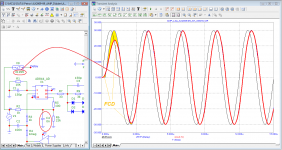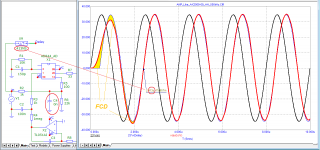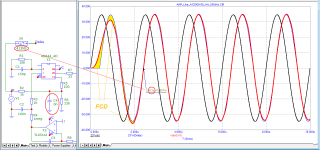A simple way to remember the difference between linear and non-linear distortion is to realize that linear distortion does not create harmonics.
Linear distortion like non-flat frequency response and phase shift do not create harmonics and can result from equipment consisting of perfectly linear, ideal components.
Non-linear distortion results from components that are non-linear and that will create harmonics.
Note also that the difference between harmonic distortion (THD) and intermodulation distortion (IMD) is only due to the way they are measured. They are both the result of the exact same non-linearity in the equipment. The various test methods, like THD, IMD, DIM-30 etc. all measure the same non-linearity but in different ways and are developed in an attempt to find a test method that correlates with listening tests.
Jan
IIRC Bob Cordell talks about this and points out that a well thought out IMD test will expose almost all forms of non-linear distortion. You really don’t need much else to characterize an amp. Of course if you have a complex music waveform, then the resultant IMD will be like grass. But in a good amp it’s peak at full output power will be << -100 dB down.
Almost all textbooks on linear distortions say that this concept and the term "linearity" refers to the steady state. Graham also wrote about this many times, citing quotations from radio technical reference books. For clarity, I took the frequencies 333 and 500 kHz.
Jan, expand the first period using Fourier and prove that there are no other components in it except the fundamental frequency.
I showed earlier what happens in the first period of a 20 kHz signal
Jan, expand the first period using Fourier and prove that there are no other components in it except the fundamental frequency.
I showed earlier what happens in the first period of a 20 kHz signal
Attachments
Petrov, you still do not understand. You want more complaints from everybody here? Again you use non standard signal. Show us that such signal can be present in audio recording.
Perhaps you need to take lessons in English language before continuing discussion.
Perhaps you need to take lessons in English language before continuing discussion.
Last edited:
Petr, don't twist my words. I never said there are no harmonics in the first section. There clearly are harmonics, they are coming from the infinitely fast starting first wave which is full of harmonics. I have said that repeatedly.
Assuming you have a perfectly linear amplifier with zero non-linear distortion, you STILL will see the linear distortion due to the fact that every amplifier has a low pass characteristic as it basically is an integrator.
You have given this linear distortion many different names for reasons I do not know.
Jan
Assuming you have a perfectly linear amplifier with zero non-linear distortion, you STILL will see the linear distortion due to the fact that every amplifier has a low pass characteristic as it basically is an integrator.
You have given this linear distortion many different names for reasons I do not know.
Jan
Almost all textbooks on linear distortions say that this concept and the term "linearity" refers to the steady state.
Often, in this context, the term 'time-invariant' is used. Do you mean that with your term 'steady state'?
Jan
If we include in series the n-th number of generators with frequencies and phase corresponding to the harmonics of the square wave signal, then at the end of the period of the fundamental harmonic, we will immediately get a meander, and not something else. There is an animated vector drawing demonstrating this process.
The sinusoid is formed in the same way. The vector makes one full revolution and a sinusoid is obtained consisting of only one harmonic, without an infinite number of additional harmonics. There are many animated drawings of this process on the Internet. In order for additional harmonics to appear, the vector forming the sinusoid must jerk convulsively both in amplitude and convulsively change the rotation speed.
Jan, you would convince me otherwise if the first oscillator period at the amplifier input contained this infinite spectrum of harmonics that you are talking about. But this does not happen, since the simulator makes a periodic signal from one sinusoid.
The sinusoid is formed in the same way. The vector makes one full revolution and a sinusoid is obtained consisting of only one harmonic, without an infinite number of additional harmonics. There are many animated drawings of this process on the Internet. In order for additional harmonics to appear, the vector forming the sinusoid must jerk convulsively both in amplitude and convulsively change the rotation speed.
Jan, you would convince me otherwise if the first oscillator period at the amplifier input contained this infinite spectrum of harmonics that you are talking about. But this does not happen, since the simulator makes a periodic signal from one sinusoid.
... the simulator makes a periodic signal from one sinusoid.
You still do not understand.I don't know if you will understand this or not but to make a valid proof, real measurement is required, simulation result alone is not enough. Use real signals present in an audio recording. Avoid use of hypothetical signals.
Jan, you would convince me otherwise if the first oscillator period at the amplifier input contained this infinite spectrum of harmonics that you are talking about. But this does not happen, since the simulator makes a periodic signal from one sinusoid.
Well you yourself showed us graphs with this 'first oscillator' period showing an infinitely starting sine wave, and the amp output 'slowly' (relatively) catching up.
That definitely contains many harmonics in the input signal. Do you agree?
Look, can we agree on the above? If so, what is the point your are trying to make? What is your conclusion, and what is it based on? Can we have a meaningful discussion instead of being bombarded with graphs that nobody knows what the point it?
Jan
Petr, don't twist my words. I never said there are no harmonics in the first section. There clearly are harmonics, they are coming from the infinitely fast starting first wave which is full of harmonics. I have said that repeatedly.
Fast d(Vin) could help, but he is faster.
Jan, expand the first period using Fourier and prove that there are no other components in it except the fundamental frequency.
petr, may I ask, how do you see the test input signal?
A.
I tell the simulator to produce a sine
I see a sine
A sine has only a single frequency
or
B.
I start a sine at time t
The sine didn't exist before t
Therefore the sine is amplitude modulated
An amplitude modulated sine has a spectral content with signals more than the sine carrier.
Or I might completely misunderstood your reasoning and there other alternatives I didn't think about 😉
/örjan
Petr, a suggestion. I assume you have a point to make about reproduction quality of amplifiers with different bandwidth, or different GD, or something else.
To make that point you continue use a non-existing test signal (infinitely fast starting sine). So a lot of the discussion is about why using a non-existing signal to test.
If you can prove your point without needing to use non-existing signal, that would make everything so much easier to discuss.
On the other hand, if the point you try to make only can be made with a non-existing signal, that is an indication that your point probably is wrong.
Jan
To make that point you continue use a non-existing test signal (infinitely fast starting sine). So a lot of the discussion is about why using a non-existing signal to test.
If you can prove your point without needing to use non-existing signal, that would make everything so much easier to discuss.
On the other hand, if the point you try to make only can be made with a non-existing signal, that is an indication that your point probably is wrong.
Jan
Or do the test with incremental levels of audio range multitones, showing that the noise level is increasing with the level.
When the amp’s GD is made switchable, you might be succesful proving your theory when things get worse with a higher GD.
The example I gave a number of postings back in #199, showed no increase in noise between 8R@80Watt and 4R@160Watt with 19K & 20K, but a multitone might prove to be more effective.
But first of all test your equipment without amp to prove that the test gear produces noise way below the amp with this multitone test.
Hans
When the amp’s GD is made switchable, you might be succesful proving your theory when things get worse with a higher GD.
The example I gave a number of postings back in #199, showed no increase in noise between 8R@80Watt and 4R@160Watt with 19K & 20K, but a multitone might prove to be more effective.
But first of all test your equipment without amp to prove that the test gear produces noise way below the amp with this multitone test.
Hans
Last edited:
Hans you seem to have a better grip on this than I do. Is that the point we are discussing, that noise level increases with GD?
Jan
Jan
Hi Jan,
I think that multitone would be a good start.
Everything happening outside our hearing range might have it’s repecussions in the audio range, but one should primarily concencetrate on what happens below supersonic.
First cycle distortion and distortion from linear cirrcuits are a no, no’s.
And of course things like crossover distortion will be deminished with a higher BW, but how far should one go ?
That could all become visible with the multitone test at different levels and switchable BW \ GD.
Hans
I think that multitone would be a good start.
Everything happening outside our hearing range might have it’s repecussions in the audio range, but one should primarily concencetrate on what happens below supersonic.
First cycle distortion and distortion from linear cirrcuits are a no, no’s.
And of course things like crossover distortion will be deminished with a higher BW, but how far should one go ?
That could all become visible with the multitone test at different levels and switchable BW \ GD.
Hans
Sorry Petr, this thread is turning in circles like an LP with a scratch.
You have shown this same info several times, so please stop it.
If it did not convince then, it will not convince now or in the future.
IMO you take the wrong route to convince.
Hans
You have shown this same info several times, so please stop it.
If it did not convince then, it will not convince now or in the future.
IMO you take the wrong route to convince.
Hans
- Home
- Amplifiers
- Solid State
- Musings on amp design... a thread split



